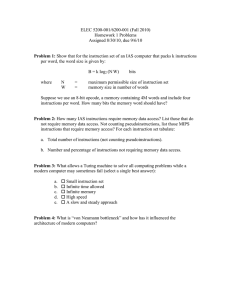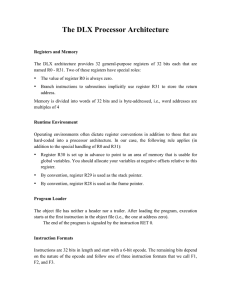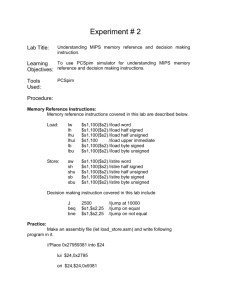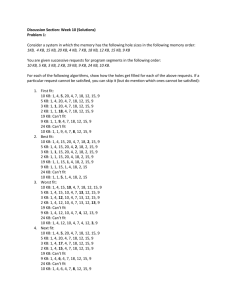ECS 50 MIPS - CS-CSIF
advertisement
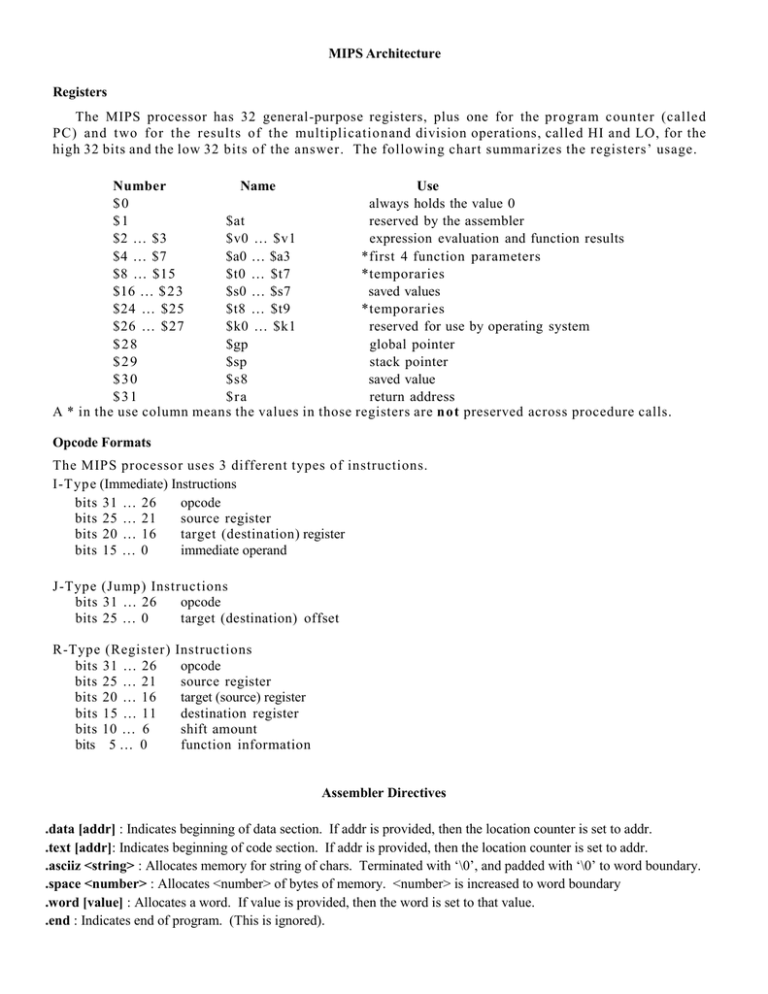
MIPS Architecture Registers The MIPS processor has 32 general-purpose registers, plus one for the program counter (called PC) and two for the results of the multiplication and division operations, called HI and LO, for the high 32 bits and the low 32 bits of the answer. The following chart summarizes the registers’ usage. Number Name Use $0 always holds the value 0 $1 $at reserved by the assembler $2 … $3 $v0 … $v1 expression evaluation and function results $4 … $7 $a0 … $a3 *first 4 function parameters $8 … $15 $t0 … $t7 *temporaries $16 … $ 2 3 $s0 … $s7 saved values $24 … $25 $t8 … $t9 *temporaries $26 … $27 $k0 … $k1 reserved for use by operating system $28 $gp global pointer $29 $sp stack pointer $30 $s8 saved value $31 $ra return address A * in the use column means the values in those registers are n ot preserved across procedure calls. Opcode Formats The MIPS processor uses 3 different types of instructions. I-T ype (Immediate) Instructions bits 31 … 26 opcode bits 25 … 21 source register bits 20 … 16 target (destination) register bits 15 … 0 immediate operand J-Type (Jump) Instructions bits 31 … 26 opcode bits 25 … 0 target (destination) offset R-Type (Register) bits 31 … 26 bits 25 … 21 bits 20 … 16 bits 15 … 11 bits 10 … 6 bits 5 … 0 Instructions opcode source register target (source) register destination register shift amount function information Assembler Directives .data [addr] : Indicates beginning of data section. If addr is provided, then the location counter is set to addr. .text [addr]: Indicates beginning of code section. If addr is provided, then the location counter is set to addr. .asciiz <string> : Allocates memory for string of chars. Terminated with ‘\0’, and padded with ‘\0’ to word boundary. .space <number> : Allocates <number> of bytes of memory. <number> is increased to word boundary .word [value] : Allocates a word. If value is provided, then the word is set to that value. .end : Indicates end of program. (This is ignored). Selection from MIPS-32 Instruction Set Load/Store Instructions Multiply/Divide Instructions LB Load Byte MULT Multiply LBU Load Byte Unsigned MULTU Multiply Unsigned LH Load Halfword DIV Divide LHU Load Halfword Unsigned DIVU Divide Unsigned LW Load Word MFHI Move From HI LWL Load Word Left MTHI Move To HI LWR Load Word Right MFLO Move From LO SB Store Byte MTLO Move to LO SH Store Halfword SW Store Word SWL Store Word Left J Jump SWR Store Word Right JAL Jump and Link JR Jump to Register JALR Jump and Link Register BEQ Branch on Equal BNE Branch on Not Equal BLEZ Branch on Less than or Equal to Zero BGTZ Branch on Greater than Zero BLTZ Branch on Less than Zero BGEZ Branch on Zero BLTZAL Branch on Less than Zero and Link BGEZAL Branch on Arithmetic Instructions (ALU Immediate) ADDI Add Immediate ADDIU Add Immediate Unsigned SLTI Set on Less Than Immediate SLTIU Set on Less than Immediate Unsigned ANDI AND Immediate ORI OR Immediate XORI Exclusive OR Immediate LUI Instructions LoadArithmetic Upper Immediate Jump & Branch Instructions Zero and Link Shift and Special Instructions (3-operand, Register Type) ADD Add SLL Shift Left Logical ADDU Add Unsigned SLLV Shift Left Logical, Variable SUB Subtract SRA Shift Right Arithmetic SUBU Subtract Unsigned SRAV Shift Right Arithmetic, Variable SLT Set on Less Than SRL Shift Right Logical SLTU Set on Less Than Unsigned SRLV Shift Right Logical, Variable AND Bitwise And BREAK Break OR Bitwise OR SYSCALL System Call XOR Bitwise exclusive OR NOR NOR Rules on Delays and Interlocks • • • • There is one delay slot after any branch or jump instruction, i.e., the following instruction is executed even if the branch is taken. That following instruction must not be itself a jump or branch. There is one delay slot after a “load” no matter what size is being loaded. That is, the instruction after a “load” must not use the register being loaded. Multiplication will place its results in the LO and HI registers after an undefined number of following instructions have executed. There’s a hardware interlock to stall further multiplications, divisions, or move from LO or HI to execute until the operation is finished. Division is like multiplication but most likely slower. MIPS Opcodes and Formats These are synopses of many of the core MIPS instructions. Not all instruction s are listed; i n p a r t i c u l a r , those i nvol vi n g traps, floats, or m e m o r y management are omitted. ADD rd, rs, rt add Opcode: 000000 Adds rs and rt, puts result into rd. Exception on overflow. Func: 100000 ADDI rt, rs, immediate add, immediate Opcode: 001000 Sign-extends the 16-bit immediateto 32 bits, adds it to rs, puts resulti nt o rt. Exception on overflow. ADDIU rt, rs, immediate add, unsigned immediate Opcode: 001001 Sign-extends the 16-bit immediateto 32 bits, adds it to rs, puts resulti nt o rt. Never causes an overflow. ADDU rd, rs, rt add, unsigned Opcode: 000000 Adds rs and rt, puts result into rd. Never causes an overflow. Func: 100001 AND rd, rs, rt and Bitwise and’s rs and rt, puts result into rd. Func: 100100 Opcode: 000000 ANDI rt, rs, immediate and, immediate Opcode: 001100 Sign-extends the 16-bit immediateto 32 bi ts , bit wi s e and s i t wi th rs, puts result into rt. BEQ rs, rt, offset branch equal Opcode: 000100 I f rs == rt, branches to offset[after executing the following instruction] . For most assemblers, offset is a label. BGEZ rs, offset branch greater-equal-zero Opcode: 000001 rt: 00001 If rs 0, branches to offset [after executing the f ollowing instruction] . For most assemblers, offset is a label. BGEZAL rs, offset branch greater-equal-zero, and link Opcode: 000001 rt: 10001 If rs 0, branches to offset [after executing the following instruction] . For most assemblers, offset is a label. Always places address of followi n g i nst r uct i o n i nt o r31. Note that rs may not itself be r31. (This is a subroutine call instruction) BGTZ rs, offset branch greater-than-zero Opcode: 000111 If rs > 0, branches to offset [after executing the following instruction] . For most assemblers, offset is a label. BLEZ rs, offset branch less-equal-zero Opcode: 000110 If rs 0, branches to offset [after executing the f ollowing instruction] . For most assemblers, offset is a label. BLTZ rs, offset branch less-than-zero Opcode: 000001 rt: 00000 If rs < 0, branches to offset [after executing the following instruction] . For most assemblers, offset is a label. BLTZAL, rs offset branch less-than-zero, and link Opcode: 00001 rt: 10000 If rs < 0, branches to offset [after executing the following instruction]. For most assemblers, offsetis a label. Always places address of foll owi ng i nst r uct i o n i nt o r31. Note that rs may not itself be r31. ( T h i s i s a s u b r o u t i n e c a l l f u n c t i o n . ) BNE rs, rt, label branch not-equal Opcode: 000101 I f r s r t branches to offset [after executing the following instruction]. For most assemblers, offset is a label. BREAK break Opcode: 000000 Causes a Breakpoint exception that transfers control to the exception handler. func: 001101 DIV rs, rt divide Opcode: 000000 func: 011010 Divides rs by rt, treating both as (signed) 2’s complement numbers. Quotient goes into special register LO and remainder into special register HI. Get them via the MFHI and MFLO instructions. No overflow exception occurs, and the result is undefined if r t c ontains 0. Note that divides take an undefined amount of time; other instructions will execute in parallel. MFHI and MFLO will interlock until the division is complete. DIVU rs, rt divide, unsigned Opcode: 000000 func: 011011 Divides rs by rt, treating both as unsigned numbers. Quotient goes into special register LO and remainder into special register HI. Get them via the MFHI and MFLO instructions. No overflow exception occurs, and the result is undefined if r t contains 0. Note that divides take an undefined amount of time; other instructions will execute in parallel. MFHI and MFLO will interlock until the division is complete. This instruction never causes an exception. J label jump Jump to label [after executing the following instruction]. Opcode: 000010 JAL label jump and link Opcode: 000011 Jump to label[after executing the following instruction]. Places the address of the following instruction into r31. (This is a subroutine-call instruction.) JALR rd, rs jump and link, register Opcode: 000000 func: 001001 Jump to address contained in rs [ af te r execut ing t he f oll owi n g instr uction]. Places address of following instruction into rd. Note that rs and rd may not be the same register. If rd is omitted in the assembly language, it is register 31. (This is a subroutine-call instruction.) JR rs jump, register Opcode: 000000 Jump to address contained in rs [ aft er executi ng t he f oll owi n g instr uction]. func: 001000 LA rt, addr load address into register Pseudo instruction This is a a pseudo inst ruction that is translated into : lui $rt, addr (16..31) followed by ori $rt, $rt , addr(0..15) LB rt, offset(rs) load byte Opcode: 100000 Sign -extend the 16-bit offsetto 32 bits, and add it to rsto get an effective address. Load the byte from this address into rt and sign-extend i t t o f i l l t h e e n t i r e r e g i s t e r . LBU rt, offset(rs) load byte, unsigned Opcode: 100100 Sign -extend the 16-bit offset to 32 bits, and add it to rs to get an effective address. Load the byte from this address into rt and zero-extend i t t o f i l l t h e e n t i r e r e g i s t e r . LH rt, offset(rs) load halfword Opcode: 100001 Sign -extend the 16-bit offsetto 32 bits, and add it to rs to get an effective address. Load the halfword (16 bits) from this address into r t a n d s i g n - e x t e n d i t t o f i l l t h e e n t i r e r e g i s t e r . Exception if odd address. LHU rt, offset(rs) load halfword, unsigned Opcode: 100101 Sign -extend the 16-bit offsetto 32 bits, and add it to rs to get an effective address. Load the halfword (16 bits) from this address into rt and zero-extend it to fill the entire register. Exception if odd address. LI rt, immediate load a 32-bit immediate into a register Pseudo instruction This is a a pseudo inst ruction that is translated into: lui $rt, i mmediate(16..31) followed by ori $r t, $rt, i mmediate(0..15) LUI rt, immediate load upper immediate Opcode: 001111 P u t 1 6 -b i t immediate in the top half of rt and fill t he bott o m hal f wi t hzeros. LW rt, offset(rs) load word Opcode: 100011 Sign -extend the 16-bit offsetto 32 bits, and add it to rs to get an effective address. Load the word (32 bits) from this address into rt. Exception if address is not word-aligned. MFHI rd move from HI Opcode: 000000 func: 010000 Move contents of special register HI into rd. Neither of the two instructions following this may modify the HI register ! Note that multiplication and division put results into HI. MFHI stalls until t ha t operati o n is complete. MFLO rd move from LO Opcode: 000000 func: 010010 Move contents of special register LO into rd. Neither of the two instructions following this may modify the LO register! Note that multiplication and division put results into LO. MFLO stalls until that oper ati o n i s complete. MTHI rs move to HI Opcode: 000000 func: 010001 Move contents of rsinto special register HI. May cause contents of LO to become undefined; no need to get specific here; just be sure to do MTLO too. MTLO rs move to LO Opcode: 000000 func: 010011 Move contents of rsinto special register LO. May cause contents of HI to become undefined; no need to get specific here; just be sure to do MTHI too. MULT rs, rt multiply Opcode: 000000 func: 011000 Mult ipl ie s rs by rt, treating both as (signed) 2’s complement numbers. Low word of result goes into special register LO and high word into special register HI. Get them via the MFHI and MFLO instructions. No over-flow exception occurs. Note that multiplies take an undefined amount of time; other instructions will execute in parallel. MFHI and MFLO will interlock until the multip licatio n is co m plete . MULTU rs, rt multiply, unsigned Opcode: 000000 func: 011001 Mult ipl ie s rs by rt, treating both as unsigned numbers. Low word of result goes into special register LO and high word into special register HI. Get them via the MFHI and MFLO instructions. No overflow exception occurs. Note that multiplies take an undefined amount of time; other instructions will execute in parallel. MFHI and MFLO will interlock until the multiplication is complete. This instruction never causes an exception. NOP no-op Pseudo instruction Do nothing for one cycle; good for filling a delay slot. Assemblers often use sll $0, $0, 0. NOR rd, rs, rt nor Opcode: 000000 Perfor ms bitwise logical nor of rs and rt, putt in g r esul t into rd. func: 100111 OR rd, rs, rt or Opcode: 000000 Per for ms bit wi se logi ca l or of rs and rt, put ting r esul t i nt o rd. func: 100101 ORI rt, rs, immediate or, immediate Opcode: 001101 Zero-extends 16-bit immediate t o 32 bi t s, and bi t wi s e or s i t wi t h rt, put t i n g r esul t i nt o rd. SB rt, offset(rs) store byte Opcode: 101000 Sign -extend the 16-bit offset to 32 bits, and add it to rs to get an effective address. Store least significant byte from rt into this address. SH rt, offset(rs) store halfword Opcode: 101001 Sign-extend the 16-bit offsetto 32 bits, and add it to rs to get an effective address. Store least significant byte from rt into this address. Exception if odd address. SLL rd, rt, sa shift left logical Opcode: 000000 func: 000000 Shift contents of rt left by the amount indicated in sa, insertion zeroes into the emptied low order bits. Put the result into rd. SLLV rd, rs, rt shift left logical, variable Opcode: 000000 func: 0001000 Shift contents of r t left by the amount indicated in the bottom five bitsof rs (0..4), inserting zeros into the low order bits. Put result into rd. SLT rd, rs, rt set on less-than Opcode: 000000 I f rs < rt with a signed comparison, put 1 into rd. Otherwise put 0 into rd. func: 101010 SLTI rt, rs, immediate set on less-than, immediate Opcode: 001010 Sign -extend the 16-bit immediate to a 32-bit value. If rs is less than this value with a signed comparison, put 1 into rt. Otherwise put 0 into rt. SLTIU rt, rs immediate set on less-than, immediate unsigned Opcode: 001011 Sign -extend the 16-bit immediateto a 32-bit value. If rs is less than this value with an unsigned comparison, put 1 into rt. Otherwise put 0 into rt. SLTU rd, rs, rt set on less-than, unsigned Opcode: 000000 If rt < rs with an unsigned comparison, put 1 into rd. Otherwise put 0 int o rd. func: 101011 SRA rd, rt, sa shift right arithmetic Opcode: 000000 func: 000011 Shift contents of rt right by the amount indicated by sa, sign-extending the high order bits. Put result into rd. SRAV rd, rs, rt shift right arithmetic, variable Opcode: 000000 func: 000111 Shift contents of rt right by the amount indicated in the bottom five bitsof rs (0..4), signextending the high order bits. Put result into rd. SRL rd, rt, sa shift right logical Opcode: 000000 func: 000010 Shift contents of rt right by the amount indicated in s a , zero -filling the high order bits. Put result into rd. SRLV rd, rs, rt shift right logical, variable Opcode: 000000 func: 000110 Shift contents of rt right by the amount indicated in the bottom five bitsof rs(0..4), zero-filling the high order bits. Put result into rd. SUB rd, rs, rt subtract Put rs – rt into rd. Exception if overflow. Opcode: 000000 func: 100010 SUBU rd, rs, rt subtract unsigned Put rs – rt into rd. Never causes exception. Opcode: 000000 func: 100011 SW rt, offset(rs) store word Opcode: 101011 Sign -extend the 16-bit offsetto 32 bits, and add it to rs to get an effective address. Store rt into this address. Exception if address is not word-aligned. SYSCALL system call Opcode: 000000 func: 001100 Causes a System Call exception. For ECS 50 the response is based on the value in $v0. 1 = print_int, 10 = exit. XOR rd, rs, rt exclusive or Opcode: 000000 Performs bitwise exclusive xor of rs and rt, putti n g resul t i nt o rd. func: 100110 XORI rt, rs, immediate xor immediate Opcode: 001110 Zero-extends 16-bit immediate to 32 bits, and bitwise exclusive xors it wi t h rs, put tin g r esult i nt o rt. MIPS Example: Initializing an Array This shows an assembly language program which initializes the integer array arr such that each of its ten elements is equal to the index of that element. It also prints the value after it is inserted in the array. # Written by: Matt Bishop and adapted by Sean Davis # Registers used: # $0 -- to get a 0 (standard usage) # $a0 –- to choose system service # $t0 -- index of arr # $t1 -- offset of current element from base of arr # $t2 -- temporary (usually holds result of comparison) # arr: init: loop: .data 0x40 .space 40 .text 0 addu $t0, $0, $0 sll $t1, $t0, 2 sw $t0, arr($t1) add $a0, $t0, $0 addi $v0, $0, 1 syscall addiu $t0, $t0, 1 slti $t2, $t0, 10 bne $t2, $0, loop nop addiu $v0, $0, 10 syscall .end # # # # # # # # # # # # # # # set start address of data section allocate 10 words set start address of instructions initialize index of array go to offset of next element store integer into element copy from $t0 to $a0 set $v0 to print_integer code for syscall print the integer in $a0 add one to current array index see if the index is 10 yet nope -- go back for another for the delay slot set $v0 to exit code for syscall exit MIPS32 Encoding of the Opcode Field opcode bits 28..26 0 1 2 3 4 5 6 7 000 001 010 011 100 101 110 111 0 000 SPECIAL δ REGIMM δ J JAL BEQ BNE BLEZ BGTZ 1 001 ADDI ADDIU SLTI SLTIU ANDI ORI XORI LUI 2 010 COP0 δ COP1 δ COP2 θδ COP1X δ BEQL φ BNEL φ BLEZL φ BGTZL φ 3 011 β β β β SPECIAL2 δ JALX ε ε SPECIAL32 δ⊕ 4 100 LB LH LWL LW LBU LHU LWR β 5 101 SB SH SWL SW β β SWR CACHE 6 110 LL LWC1 LWC2 θ PREF β LDC1 LDC2 θ β 7 111 SC SWC1 SWC2 θ ∗ β SDC1 SDC2 θ β bits 31..29 1 MIPS32 SPECIAL Opcode Encoding of Function Field function bits 2..0 0 1 2 3 4 5 6 7 bits 5..3 000 001 010 011 100 101 110 111 0 SLL1 MOVCI δ SRLV δ SRAV 000 SRL δ SRA SLLV ∗ 2 1 001 JR MOVZ MOVN SYSCALL BREAK ∗ SYNC 2 010 MFHI MTHI MFLO MTLO β ∗ β β 3 011 MULT MULTU DIV DIVU β β β β 4 100 ADD ADDU SUB SUBU AND OR XOR NOR 5 101 ∗ ∗ SLT SLTU β β β β 6 110 TGE TGEU TLT TLTU TEQ ∗ TNE ∗ 7 111 β ∗ β β β ∗ β β 2 JALR MIPS32 REGIMM Encoding of rt Field rt bits 18..16 bits 20..19 0 1 2 3 4 5 6 7 000 001 010 011 100 101 110 111 0 00 BLTZ BGEZ BLTZL φ BGEZL φ ∗ ∗ ∗ ε 1 01 TGEI TGEIU TLTI TLTIU TEQI ∗ TNEI ∗ 2 10 BLTZAL BGEZAL BLTZALL φ BGEZALL φ ∗ ∗ ∗ ∗ 3 11 ∗ ∗ ∗ ∗ ε ε ∗ SYNCI ⊕
